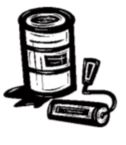Interacting with People with Significant Allergies, Asthma, Chemical and other Environmental Sensitivities, and Respiratory-related Disabilities
Up to 30 percent of the U.S. population report adverse reactions to particular chemical exposures such as pesticides, remodeling activities, new carpet, cleaning agents, air fresheners, deodorizers, tobacco smoke, and fragrances and fragranced products. Those affected can experience mild to debilitating or life-threatening reactions. People who are disabled by chemical sensitivities react to more and more substances and products at lower and lower exposure levels.
The practices below are not a “ban” on scented products, but a request to voluntarily refrain from using scented products so they become less of a barrier to access.
-
Maintain a smoke-free environment. Restrict smoking to outdoor areas at least 50 feet from building entrances, fresh air intakes, and operable windows, or designate a smoking area that meets these criteria.
-
Eliminate use of mechanical dispensers or fragrance delivery systems, which may be attached to walls or ceilings, or may be part of the building's ventilation system. These devices are used for the spreading of air fresheners, deodorizers, disinfectants, scents or scented products. Fragrance emission devices/systems and perfume and deodorizer ‘stick-ons’ are commonly used in restrooms and vehicles.
-
When there is a choice, choose facilities with windows that open to permit fresh air to circulate.
-
Avoid conventional pesticides for lawn care and structural pest control. Use Integrated Pest Management (IPM) Practices, which promote low impact, least toxic means of addressing a problem.
-
Avoid activities involving cleaning, construction, painting, maintenance, and remodeling, roofing, and pesticide applications, if necessary, during working hours; fumes can be sucked into heating, ventilation, and air conditioning systems and distributed throughout the building.
-
Provide advance notice when problematic substances are to be used.
-
Use unscented products that emit low or no volatile organic compounds (VOCs are a broad category covering room-cleaning solvents and fumes from new carpets and furniture) like solvent-free paint.
-
Keep the ventilation system well-maintained and free of contaminants.
-
Install and maintain localized exhaust systems to remove fumes from restrooms, cooking areas, copier rooms, etc.
-
Locate fresh-air intakes away from outdoor pollution sources such as trash containers, parking lots, or loading docks.
-
Prevent the growth of mold by regulating humidity, providing adequate ventilation, and by repairing leaks and replacing water damaged materials.
-
Request that people avoid the use of fragrances and fragranced personal care products such as perfume, cologne, after-shave, shampoo, conditioner, hair spray, scented powder, hand and body soaps and lotions. Post the request in public places including entrance(s) to the building or facility and restrooms. Many fragrance-free personal care and laundry products are easily available and provide safer alternatives.
-
Request that people avoid wearing newly dry cleaned clothes and clothes washed or dried with fabric softener, including the “dryer sheet”types.
-
Use fragrance-free, low toxicity cleaning products including rug shampoo, dry carpet cleaners, dish washing detergents, hand soaps, hand sanitizers, hand and body lotion, toilet paper, and cleaners.
-
Use unscented, nontoxic water-based markers for flip charts. Avoid the use of white boards because the markers and particularly the products used to clean the surface are a significant source of VOCs.
-
Consider developing a fragrance-free workplace policy, and provide workshops so people can begin to understand why these requests are important.



User Comments/Questions
Add Comment/Question